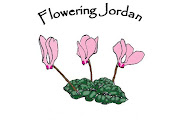My favorite early spring flower is the wild cyclamen, known in Arabic as “horns of the gazelle” for the petals of the flower which bend back to give the impression of horns. Additionally, the flower of the cyclamen is born on a long, gracefully bent stem, another resemblance to the indigenous gazelle, known for its graceful appearance and movements. (It is also known as “soap of the shepherd”. Not nearly as poetic and I’m not sure why it is so named. )
At home in the shady mountains and forests of northern Jordan, cyclamen is often found growing near rocks, the corms which they grow from secured between the crevices, protecting them from the ever present danger of grazing by sheep and goats. The leaves of this beautiful plant are edible and I have heard that some in the countryside collect them to make “mahshi”, a traditional Arabic dish of vegetables or leaves stuffed with rice and meat.
All the cyclamen I have seen in Jordan, until our trip to Gilead last Sunday, had pink-mauve flowers as in the specimen pictured below:
At home in the shady mountains and forests of northern Jordan, cyclamen is often found growing near rocks, the corms which they grow from secured between the crevices, protecting them from the ever present danger of grazing by sheep and goats. The leaves of this beautiful plant are edible and I have heard that some in the countryside collect them to make “mahshi”, a traditional Arabic dish of vegetables or leaves stuffed with rice and meat.
All the cyclamen I have seen in Jordan, until our trip to Gilead last Sunday, had pink-mauve flowers as in the specimen pictured below:

Cyclamen persicum
However, in the same field I also found a more vibrant pink cyclamen and a near white cyclamen, tipped in bright pink. These were the freshest cyclamen with the most profuse blooms I have ever seen and almost made me suspect they are some sort of hybrid introduced to the area, though I can’t imagine who would have done that.






No comments:
Post a Comment